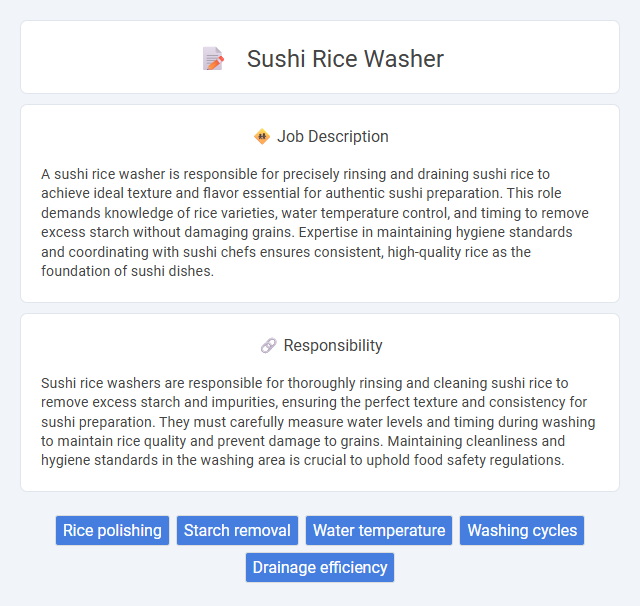
A sushi rice washer is responsible for precisely rinsing and draining sushi rice to achieve ideal texture and flavor essential for authentic sushi preparation. This role demands knowledge of rice varieties, water temperature control, and timing to remove excess starch without damaging grains. Expertise in maintaining hygiene standards and coordinating with sushi chefs ensures consistent, high-quality rice as the foundation of sushi dishes.
People who have good attention to detail and enjoy repetitive tasks may be highly suitable for a sushi rice washer job. Those who are comfortable working in a fast-paced, often humid kitchen environment will likely find the role manageable and rewarding. Individuals prone to sensitivity from prolonged exposure to water or those seeking highly varied work may find this position less fitting.
Qualification
A sushi rice washer must have expertise in selecting high-quality short-grain rice and possess meticulous attention to detail to ensure proper rinsing that removes excess starch without damaging the grains. Familiarity with traditional washing techniques and experience in maintaining precise water temperatures are essential to achieve the ideal texture for sushi rice. Strong knowledge of food safety standards and hygiene practices ensures the preparation meets stringent restaurant requirements.
Responsibility
Sushi rice washers are responsible for thoroughly rinsing and cleaning sushi rice to remove excess starch and impurities, ensuring the perfect texture and consistency for sushi preparation. They must carefully measure water levels and timing during washing to maintain rice quality and prevent damage to grains. Maintaining cleanliness and hygiene standards in the washing area is crucial to uphold food safety regulations.
Benefit
Washing sushi rice thoroughly likely improves the texture and taste of the final product, ensuring a clean and fluffy consistency. Proper rice washing may also remove excess starch, which can reduce stickiness and enhance the rice's ability to hold flavor. Consistent washing techniques probably contribute to higher quality sushi, increasing customer satisfaction and repeat business.
Challenge
The sushi rice washer role likely presents challenges in maintaining precise water temperature and washing time to achieve the ideal rice texture. There is a probability of encountering difficulty in consistently removing excess starch without damaging the grains, which impacts the final sushi quality. Attention to detail and steady hand coordination may be essential to overcome these challenges effectively.
Career Advancement
Mastering the sushi rice washer role sharpens attention to detail and consistency, foundational skills prized in culinary careers. Proficiency in rice preparation accelerates progression to sushi chef positions, where expertise in rice texture and seasoning is critical. This role serves as a strategic entry point for advancing within sushi restaurants and broader Japanese culinary arts.
Key Terms
Rice polishing
Sushi rice washers specialize in the precise process of rice polishing, crucial for achieving the ideal texture and flavor in sushi preparation. They carefully rinse and agitate rice grains to remove excess starch and impurities, ensuring optimal moisture absorption and a glossy, non-sticky finish. Mastery in rice polishing directly impacts the quality of sushi rice, enhancing its consistency, taste, and appearance for premium sushi dishes.
Starch removal
A sushi rice washer's primary responsibility is the precise removal of excess starch from the rice grains to ensure optimal texture and flavor. Proper washing techniques involve multiple rinses under cold water until the water runs clear, which prevents clumping and achieves the desired stickiness necessary for authentic sushi preparation. Mastery of starch removal directly impacts the consistency and quality of sushi rice, crucial for professional sushi chefs and high-end restaurants.
Water temperature
Sushi rice washers must maintain water temperature between 10degC and 15degC to ensure optimal rinsing without prematurely cooking the rice. Precise control of water temperature preserves the rice's starch structure, resulting in the ideal texture for sushi preparation. Consistent use of cool water minimizes rice damage and enhances the final flavor profile essential for high-quality sushi.
Washing cycles
A sushi rice washer is designed with multiple washing cycles to ensure rice grains are thoroughly cleaned, removing excess starch and impurities for perfect texture. Each cycle controls water temperature, duration, and agitation intensity to optimize rice quality specifically for sushi preparation. Efficient washing cycles contribute to uniform rice hydration, crucial for achieving the ideal stickiness and consistency required in authentic sushi dishes.
Drainage efficiency
Sushi rice washers must ensure high drainage efficiency to prevent excess water from diluting the rice texture and flavor. Proper drainage techniques remove impurities and residual starch, leading to evenly cooked, fluffy rice essential for authentic sushi. Efficient water removal also reduces drying time, enhancing overall kitchen productivity and consistency.
 kuljobs.com
kuljobs.com